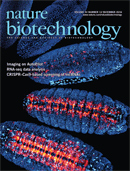Many access barriers to life-science experimentation exist for academic and commercial research, mainly due to professional training needs, equipment purchase and operation costs, and safety considerations1. Computational cloud and time-sharing paradigms2, 3 have recently inspired the development and deployment of cloud-based experimentation labs for biology research, such as commercial platforms that can execute experiments semiautomatically1, 4 and the browser-based puzzle game EteRNA, which provides experimental feedback for citizen scientists5. However, these platforms still face limitations, such as relying on batch processing with no opportunity for real-time interaction while the experiment is running, hindering the exploration that hands-on experimentation allows and taking days to return results due to long experimental turnaround times.
Cloud labs are also poised to help solve significant educational challenges. Familiarity with advanced scientific practices and 'authentic inquiry'6, 7, 8 are imperative for K–12 and college education (for example, Next Generation Science Standards)8, 9 but are difficult to achieve in real-world classrooms given logistics and cost6, 10. In addition to traditional physical hands-on labs, virtual and remote labs have recently been successfully deployed, with each modality having its distinct advantages given educational goals and situational context11, 12, 13, 14, 15. Physical remote labs for life science education are comparably underdeveloped12, in large part because of the associated logistics of specimen handling. We have previously developed, demonstrated and deployed the first educational biology cloud lab with slime mold chemotaxis experiments16, which was suited for non-real-time interactions but did not scale cost-effectively, given back-end logistics and turnaround time.
Here we conceptualize, implement and validate a biology cloud experimentation platform (Fig. 1) that (i) enables the types of inquiry mandated for professional science and educational purposes; (ii) has a low entry barrier and can be used even at the middle-school level; (iii) is real-time interactive; (iv) has a fast result turnaround time (within minutes); (v) is fault tolerant against biological variability and failure; (vi) scales to millions of users worldwide from a design as well as an economic viewpoint; (vii) has a large exploration and discovery space; and (viii) generalizes to many other experiment types.
A real-time interactive, fully automated, low-cost and scalable biology cloud experimentation platform could provide access to scientific experimentation for learners and researchers alike.



